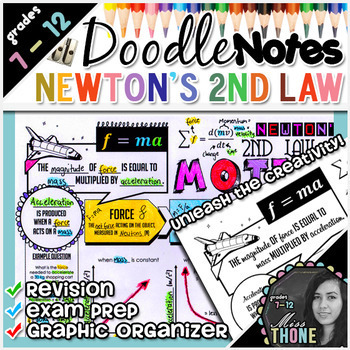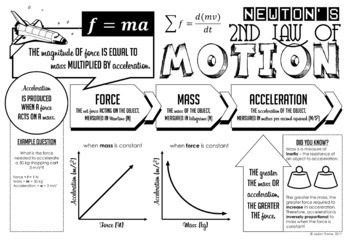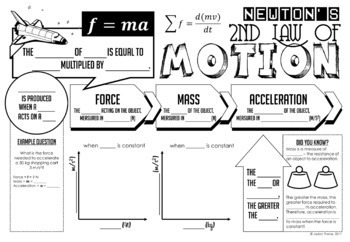Newton's Second Law of Motion Doodle Notes + Quiz
- PDF
What educators are saying
Also included in
- Newton's First Law (Inertia), Newton's Second Law (f = ma) and Newton's Third Law (Action-Reaction) graphic organizers that allow students to compile their knowledge and understanding in a doodle notes style! Give your students a welcome change of pace by leading them through the ideas and conceptsPrice $8.00Original Price $12.00Save $4.00
Description
This is a Newton's Second Law of Motion graphic organizer that allows students to compile their knowledge and understanding in a doodle notes style! Give your students a welcome change of pace by leading them through the ideas and concepts behind Newton's Second Law of Motion (force = mass x acceleration) and then gift them with time to doodle and make those connections! This graphic organizer would be great for an interactive notebook, too! Lastly, a single-sided student checking for understanding quiz to solidify knowledge ascertained during the doodling session. The quiz includes true and false prompts requiring explanation of choice, example/non-example identification and definition matching – perfect for rounding out the lesson!
Buy the BUNDLE and SAVE: Newton's Laws of Motion Bundle
⚠ Preview Product
Download the PREVIEW to view the sample completed work.
⚠ What are Doodle Notes?
It's a method of revising or introducing a topic, coined by TpT Author Math Giraffe that increases student memory, learning and focus. Doodle notes are basically graphic organisers or guided note/work sheet, but with "brain-friendly upgrades" that allow students to make connections to the text/content in ways they normally wouldn't. Students make these connections by color-coding, drawing patterns, doodling and otherwise *owning* the information in front of them. There is no "right way" to utilize doodle note resources, but it is recommended that the teacher models how to complete the sheet and the students follow along at the same time. Students should be doodling while the teacher is lecturing to create those neural pathways. Doodle Notes is a trademarked term used with permission. Please see doodlenotes.org for more information.
✂ Contents
+ 1 blank student doodle note Newton's Second Law of Motion graphic organizer in 3 levels of completion (fully completed, fill-in-the-blanks and "empty" - "empty" is great if you desire your students to add their own notes = easy differentiation!)
+ 1 doodle note teacher answer key of example completed work, doodled on in my style of doodling
+ 1 page quiz with teacher answer key
✂ Teacher Preparation Instructions
Simply print off as many copies as necessary, provide students with colored pencils, textas or crayons and watch them engage the creative side of their brain!
✂ Suggestions for Use in the Classroom
This single-sided sheet could be used as an introduction to Newton's Second Law of Motion or as independent/group review of mass/acceleration/Newton's Laws. The single-sided worksheet could be printed on the back for consolidations.
Earth Sciences / Geology Doodle Notes
Chemistry Doodle Notes
⇨ Exothermic & Endothermic Chemical Reactions
Biology Doodle Notes
Physics Doodle Notes
⇨ Intro to Energy & Law of Conservation of Energy
⇨ Newton's First Law of Motion (Inertia)
⇨ Newton's Second Law of Motion (F = ma)
⇨ Newton's Third Law of Motion (Action-Reaction)
English Language Arts (ELA) Doodle Notes
Additional Licenses
Love this product? Think a colleague would too? How about purchasing an additional license? Additional licenses for all of my products discounted!
Rate | Comment, Questions, Queries? | Follow
Did you know that you gain TPT credits, simply by rating the products you buy? Please go to your My Purchases page. Beside each purchase you'll see a Provide Feedback button. I value your feedback greatly as it helps me determine how I can tweak or touch up a product. Please don't hesitate to ask questions by visiting my Q&A tab. Lastly, to receive notifications of new products and upcoming sales, look for the green star near the top of any page within my store and click it to become a Follower.
© Jadyn Thone






